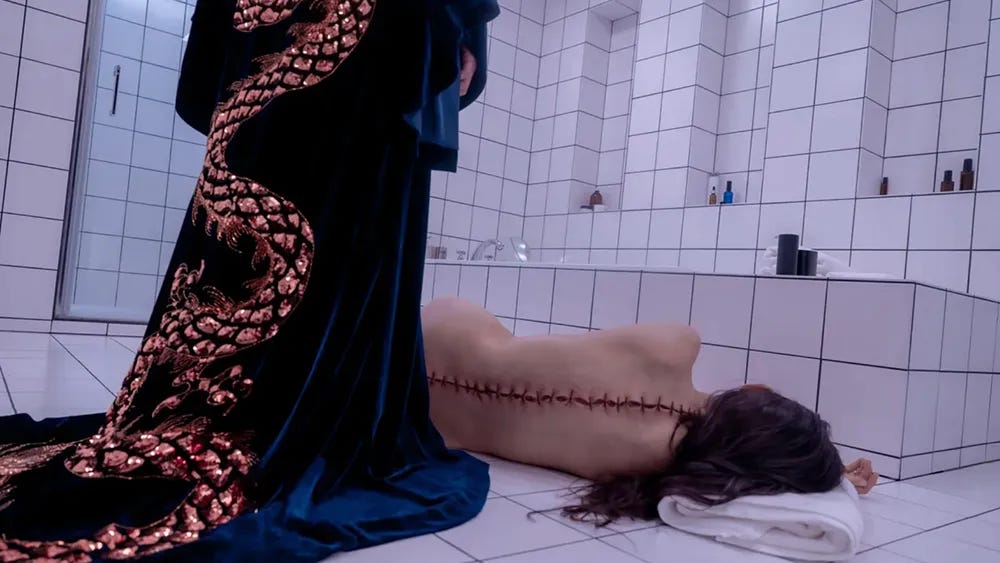In Review: 'The Substance,' 'His Three Daughters,' 'Wolfs'
Coralie Fargeat's Cannes-winning sci-fi/horror film is a gruesome tour-de-force for Demi Moore while other top-flight actors struggle to keep lesser vehicles afloat.
The Substance
Dir. Coralie Fargeat
140 min.
Coralie Fargeat is not fucking around.
With her debut feature, Revenge, the French director turned the dodgy rape-revenge formula of exploitation films like I Spit On Your Grave into a potent fantasy of feminine power, all without skimping on the midnight-movie kicks and oceans of blood. Now she’s returned with the darkly hilarious and unsparingly gruesome sci-fi/horror film The Substance and the bluntness of her all-caps feminism is still readily apparent. There’s no missing her themes of celebrity and vanity, and the toll that the patriarchal demands on women’s bodies can exact on their psyches. Though Fargeat is not given to speechifying, her crystalline images speak through a megaphone, which may not leave the audience much to sort out, but will leave their eardrums ringing like a great rock show. She is a fearless and relentlessly audacious filmmaker.
That descriptor also applies to the two lead actresses she’s cast in The Substance, starting with Demi Moore, whose past as the quintessential hardbody of ‘80s and ‘90s grounds the film in potent meta-narrative. In an opening montage that, in the Fargeat style, doesn’t obscure its meaning, a star on Hollywood’s Walk of Fame is forged for TV aerobics legend Elisabeth Sparkle (Moore) and then subject to the ravages of time, when the pavement around it cracks and loses its luster. On her 50th birthday, her grotesque boss (Dennis Quaid), between sloppy mastications of high-end shellfish, opts to fire her unceremoniously from her long-running show and go searching for a younger model. As she looks up at her billboard coming down on the drive home, Elisabeth gets into a gruesome car accident that she survives miraculously, but leaves nonetheless shaken.
The film takes a turn when an eerily handsome nurse passes Elisabeth a USB drive emblazoned with a logo for “The Substance,” a serum that offers its users the chance at a literal second life. In a sly wink to dot-com branding, the supplies come in the form of an Apple product or a meal kit: The first injection creates a new person, in this case the staggeringly beautiful “Sue” (Margaret Qualley), ripped from the body of the original, called the “matrix.” (Sue’s first task, after admiring her new figure, is to stitch Elisabeth back together.) Daily stabilizing injections are drawn from the host’s body every seven days, but at the end of that period, the bodies have to be switched. As the instructions emphasize, Elisabeth and Sue must think of themselves as one, not two, and the consequences of not switching on time are significant. Naturally, as Sue exalts in the privileges of her new body, she starts bending the rules.
The dissonance between Elisabeth and Sue is inevitable, a manifestation of a woman at war with herself. Fargeat wages a pitched battle between the two that requires Moore and Qualley to expose themselves, in every sense of the word, as The Substance starts to tilt toward Cronenbergian body horror. Yet the film, as viscerally disgusting as it gets—count Carrie and Cronenberg’s The Fly among the influences, though John Frankenheimer’s Seconds is the matrix here—is also consistently hilarious. The show-within-a-show is an amusing ticket to fame, as if the ‘80s aerobic craze had not only never ended, but seems like the primary avenue for women to find success in Hollywood. Fargeat also gets tremendous mileage out of the generational resentment that builds up between Elisabeth and Sue, who each hold power over one another for their seven days of consciousness and quickly abandon any sense of esprit de corps. After all, a society that pits women against each other helps sustain their oppression.
At 140 minutes, The Substance tries to wring perhaps too much out of its premise, but Fargeat is determined to take this metaphysical battle royale as far as it can go, including a finale that’s as deliriously excessive as the climax of Revenge. Moore’s willingness to discard her vanity to commit to Fargeat’s thesis is almost heroic, in that she’s prepared to supplement her glamorous past in films like Indecent Proposal and Striptease with an extended look at her body in late middle age. Qualley does something like the inverse, coming into the film at her youthful peak in order to expose the echoes that whistle through her character’s hollow soul. The Substance is a radical, grisly, cult-ready statement—with each passing minute, you can see the film slip to a smaller and more intrepid distributor, in this case Mubi—and its clarity of purpose slides like a needle under the skin. — Scott Tobias
The Substance opens in limited release this week.
His Three Daughters
Dir. Azazel Jacobs
101 min.
The end is near from the start of His Three Daughters. Written and directed by Azazel Jacobs, this intense, intimate drama unfolds almost entirely within the cramped walls of a small, but extremely affordable, Manhattan apartment where three sisters have gathered to tend to their father Vincent (Jay O. Sanders) while he receives at-home hospice care. One, Rachel (Natasha Lyonne), has been there the whole time, living with Vincent while spending her days betting parlays with absurdly long odds and smoking as much weed as possible. A second, Katie (Carrie Coon), rarely makes the trek from Brooklyn to visit but attempts to command the situation with the same high-strung energy she apparently brings to every aspect of her life. A third, Christina (Elizabeth Olsen), has come in from far away and seems determined to stay that way, mentally if not physically.
Vincent’s fate is already written, but the future of his family after he’s gone remains very much undetermined, and a string of conflicts and perceived failures make the outlook appear pretty grim. Though told such a document is pretty much pointless at this stage, for instance, Katie focuses on Rachel’s failure to get their father to sign a DNR. Despite having been there the longest, Rachel can’t quite bring herself to take a shift by her father’s bedside. Christina brings the sunniness of a lifelong Deadhead, but her attempts to remain upbeat feel at best like a failure to read the room and at worst like a lie she tells herself.
The film slowly unpeels the sisters’ complicated and thorny history as the conflicts intensify, alliances shift, and their father’s condition hovers on the brink of death. In one of His Three Daughters’ best scenes, a change in breathing sends all three into a panic and, for a moment, they’re all in exactly the same place: the conflicted emotions when the feeling of not wanting a loved one to hang on and suffer clashes with the terror of actually losing them forever.
It’s also one of the few moments that feel cinematic. Though not adapted from a play, His Three Daughters often feels like it originated on stage. That’s not entirely a bad thing. Jacobs’ dialogue is sharp, the exchanges are charged, and the claustrophobia heightens the intensity as the film builds to a third act that takes an unexpected turn. But the film also depends on its leads fleshing out roles that often feel more like types than fully considered characters. It’s a trick Lyonne pulls off throughout, Olsen manages most of the time, and Coon meets only after a string of early scenes in which Katie is allowed to be little more than an overbearing cliché. The cumulative effect is quite moving, but the film’s bumpiness doesn’t always come from the story it tells. —Keith Phipps
Wolfs
Dir. Jon Watts
108 min.
Where do movies belong? That’s a question raised by factors both within and without Wolfs, Jon Watts’ first film as writer and director after the end of his Spider-Man tour of duty. Originally scheduled to enjoy a high-profile release, the Apple Original Films production saw that strategy altered late in the game after Apple experienced a string of box office disappointments. Instead, it will open in some theaters this week before appearing on Apple TV+ on September 27th. On the face of it, that seems a shame. A lighthearted crime film with a pair of A-list stars — George Clooney and Brad Pitt — is a true rarity in this franchise-dominated moment. And, shot by Larkin Seiple (Everything Everywhere All at Once), it’s a good looking movie, too. Seen on the big screen, its crisp digital photography and moody, onset-of-winter setting really pop. Yet for all its star power and production value, Wolfs feels tailor-made to be watched at home by those in search of the unchallenging, entertaining-enough fare that’s come to define made-for-streaming sort-of blockbusters.
Clooney and Pitt play a pair of nameless characters (we’ll just call them “Clooney” and “Pitt” for simplicity’s sake) who both believe themselves to be the best at what they do: serving as fixers for high-powered New Yorkers who need problems to go away. They’re unaware of each other’s existence, however, until both receive the call to deal with the same problem. In the penthouse of a luxury hotel, Margaret (Amy Ryan), an up-for-reelection DA with a reputation for being tough on crime, has engaged in a tryst with a younger man (played by Austin Abrams and referred to only as “Kid”), who, after jumping on the bed, face plants on the floor and appears to die. Clearly, a fixer is required. But are two fixers required? Forming a makeshift partnership that’s half team-up, half pissing contest, Pitt and Clooney set about clearing the scene in hopes of going their separate ways. Two complications stand in the way: a backpack filled with drugs and the fact that not everyone who seems to be dead really is dead.
That’s not a bad set-up for a double star vehicle, but everyone involved seems to have thought that a set-up was all the film needed. It’s a testiment to Clooney and Pitt’s charisma that it takes about half a film to realize that their characters aren’t mysterious and cool so much as empty canvases for their familiar star personas. A plot that never kicks into gear and dialogue that falls flat despite the cast’s best efforts doesn’t help, nor do merely competent set pieces that outstay their welcome, particularly a long chase across seemingly the breadth of Manhattan that climaxes in a truly unimpressive bit of slow motion. Is it good enough to pass the time at home? Maybe. But with so many other movies available with just the push of a button, why click on this one? —Keith Phipps











For genre fans, I've seen The Substance repeatedly compared to Society, as well as more obscure titles like Boxer's Omen, and that just makes me more eager to see it this weekend in a full recreation of the "Sickos" guy.
Caught The Substance last night and probably liked it a bit less than the review. It does a lot of Verhoeven / Cronenberg / Society stuff well, but none of it is original and it’s waaaaay too long.